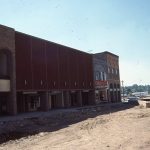
Land development took on many styles as Cuyahoga Falls burst at the seams in the 1900s.
Broadbeck Park was one example. Francis Broadbeck purchased the Fred Post farm on Sackett Avenue, 100 acres of open land. He had it laid out with six streets running north and south and two streets east and west with lots also facing Sackett on his side, a total of 385 lots.
Next, the streets were graded to established grades and sewer and water lines were installed in all streets. The sewers all ran to the southwest corner of the development, which was the lowest spot in elevation. A septic tank was installed, with Pine Gull Stream for its outlet.
It was necessary for service to install electric lines and water lines several blocks out Sackett Avenue, thus furnishing service for existing residents on that street.
Next, five-foot-wide concrete sidewalks were constructed in front of all lots and two soft maple saplings about 18 inches high were planted on the front of each lot. Planting cost one cent per tree.
Thus in 1919, the land sales were begun in a sales office constructed on Sackett Avenue and free lunches served to prospective buyers.
The north and south streets were all given names with a heritage value, like Broadbeck Avenue, Post Avenue, etc. Those names have been dropped and numbers 14-19 given. The east and west streets were Falls and Broad Streets, but it was after 1927 before the connection was established with their counter downtown.


Akron Gardens in old Northampton Township on the south side of Northampton Road (now Portage Trail) was laid out with the smallest lots of the time and to obtain council approval, the town was given the southwest corner, a swampy worthless section of land (now beautiful Oak Park).


Schiller’s Northern Heights Allotment on the north side of Northampton Road (Portage Trail) was laid out on the ground and all roads graded, then flagstone five-foot-wide sidewalks were placed along the front of all lots. The flagstone was hauled by horse and wagon from the stone quarry at Peninsula.

The North Haven area was laid out in the late 1920’s and along with sewer, water and concrete sidewalks, white way light standards were installed and stood like monuments in the open fields until the depression ended and World War II was underway and the now City of Cuyahoga Falls took on a new boom.
Written By Eric Thompson



